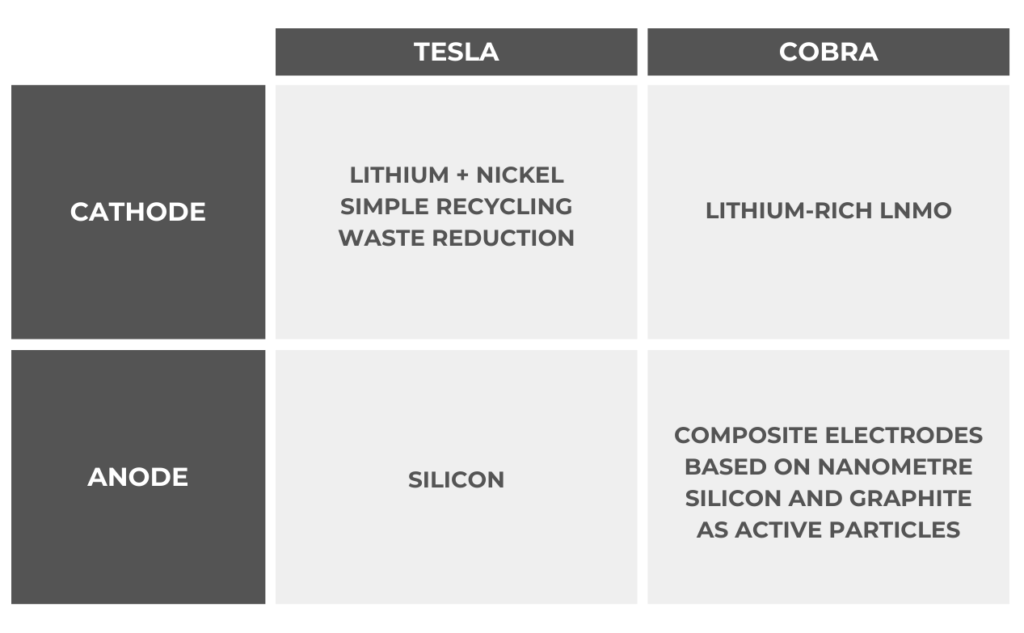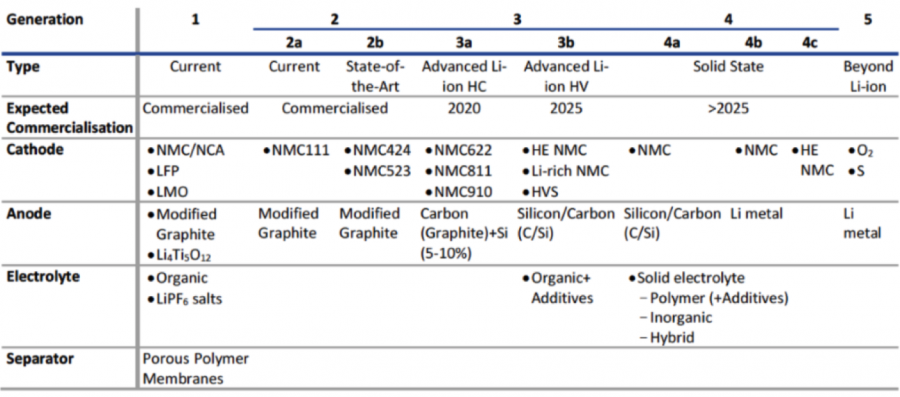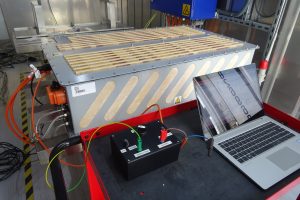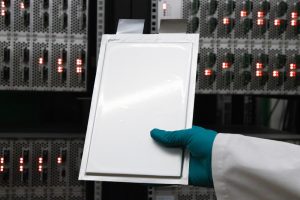Tesla vs COBRA: A look at Tesla's Battery Day
The increasing trend of electrification in mobility demands the critical transformation of lithium-ion batteries to cope with sustainability concerns while increasing their performance and keeping them affordable. Tesla, one of the main industry players in the electric vehicle field, had its long-awaited ‘Battery Day’ last week where it presented its focus for future technologies addressing the above-mentioned challenges. Aligned with COBRA’s vision to develop cobalt-free, sustainable and cost-efficient batteries, Tesla will focus on simplifying cell design, removing cobalt, and expanding its manufacturing capacity. We’ve prepared a concise overview of the most relevant technologies announced by Tesla and how they compare to our work in COBRA.

Tabless cells
One of the new exciting technologies announced by Tesla was their novel tabless cell design. These tabless cells are not only considerably larger than current ones – at 46x80mm compared to 18x65mm – they perform much better and are even cheaper. At an electrochemical level, the tabless design replaces the small conductive area of the tab with a wide interface, leading to more balanced electrochemical rates, lower heat generation, lower electron travelling distance, and a lower reduction in resistance. This, in combination with the cell size, results in a cell with 5x more energy storage and 6x more power capacity.
In terms of manufacturing, the new design eliminates the tab welding step, contributing to the reduction of manufacturing times and increased production capacity, therefore reducing production costs. For this specific cell, Tesla estimates a 14% reduction in production costs.
Cobalt-free cathodes
An increase in cobalt mining has negatively impacted local ecosystems, as well as societies. The Democratic Republic of the Congo (DRC), where 70% of cobalt is sourced from, still uses artisanal miners, often underage.
Aiming to address these concerns, Tesla suggests the unique use of nickel and lithium for cathode development. Together with the elimination of the solvent addition step and the simplification of the metal fining, this design will help reduce waste and enable simple recycling, fostered by more sustainable and local extraction. The University of Texas already reported test results using this design, which proved that although the energy density is slightly lower, the battery was able to operate at higher voltages and similar charge pace. Hence, efforts should be placed in improving such a cathode to reach exceptional energy density. Sharing similar concerns about cobalt mining, COBRA is working on an entirely cobalt-free cathode based on nickel and lithium. However, our project will combine these materials in an LNMO cathode as opposed to the unique use of lithium and nickel by Tesla.
Silicon anodes
Tesla wants to move away from carbon-based anode materials such as graphitic carbon and graphene and instead use silicon-based anodes. This will address several issues, the most important being energy density. This is because silicon has almost ten times the (theoretical) capacity compared to carbon-based materials, at some 3500mAh/g. Next to its superior electrochemical performance, silicon is the most abundant material on earth after oxygen, eliminating potential shortage issues.
On the downside, silicon suffers from high volume changes during cycling which accelerates battery degradation and has a high initial irreversible capacity loss. Nevertheless, as multiple institutions have been working for years on silicon anodes, several approaches have been suggested to mitigate these issues., e.g. the use of flexible substrates such as fabrics to cope with interface stress.
Overall, Tesla’s strategy is in line with the expected anode developments and coincides with generation 3b anodes as defined by European battery consortia, expected to be commercialised around 2025. COBRA’s developments are also in line with these expectations, although COBRA will work with silicon-graphite composite anodes to cope with Si expansion and other issues.

Increased production
Tesla has also announced plans to increase cell production, although the company will continue working with external suppliers as well. This shows their intention of ramping up vehicle capacity and gaining a higher vehicle market share, supporting their goal of offering a $25,000 EV. The cheaper EV will justify the additional production capacity, which will in turn allow for the economies of scale to reduce its cost!
The COBRA consortium is very happy to see that big industry players like Tesla are following similar paths to more holistically sustainable solutions for EV batteries, and is looking forward to seeing what other key players will suggest towards EV sustainability!
If you’d like further details on the latest developments in COBRA, or want to reach out to one of the partners, contact cobra@baxcompany.com or visit our Twitter and LinkedIn channels.




